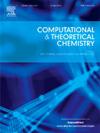苯基脲/硫脲衍生物功能化碳和碳化硅纳米管的氟化物、氯化物和溴化物络合行为:从头开始研究
IF 3
3区 化学
Q3 CHEMISTRY, PHYSICAL
引用次数: 0
摘要
研究了设计的苯基脲和苯基硫脲衍生物受体及其在(5,5)扶手碳纳米管和碳化硅纳米管上的功能化行为,并对其氟、氯和溴络合行为进行了研究。采用从头算方法系统计算了苯脲衍生物、苯基硫脲衍生物、苯基脲衍生物、碳化硅衍生物、苯基脲衍生物、苯基硫脲衍生物、碳化硅衍生物的结构、能量和电子性质,以及它们与所研究离子的配合物。结果表明,所研究的离子均可通过氢键相互作用促进的放热过程与受体形成稳定的配合物。值得注意的是,氟离子与所有设计的受体表现出最强的络合作用。此外,受体在气体、水和DMSO相中的电子性质在与所研究的离子络合后显著改变。这些发现表明所有受体在卤化物离子传感应用中都显示出强大的潜力。本文章由计算机程序翻译,如有差异,请以英文原文为准。

Fluoride, chloride, and bromide complexation behaviors of carbon and silicon carbide nanotubes functionalized with phenyl-urea/thiourea derivatives: An ab initio investigation
Designed receptors of phenyl-urea and phenyl-thiourea derivatives and their functionalization on (5,5) armchair carbon and silicon carbide nanotubes were investigated for their fluoride, chloride, and bromide complexation behaviors. Structural, energetic, and electronic properties of phenyl-urea derivatives, phenyl-thiourea derivatives, carbon nanotubes functionalized with phenyl-urea derivatives, silicon carbide nanotubes functionalized with phenyl-urea derivatives, carbon nanotubes functionalized with phenyl-thiourea derivatives, and silicon carbide nanotubes functionalized with phenyl-thiourea derivatives, as well as their complexes with studied ions, were systematically computed using an ab initio method. The results reveal that all studied ions can form stable complexes with the receptors via exothermic processes facilitated by hydrogen bonding interactions. Remarkably, the fluoride ion exhibits the strongest complexation interaction with all designed receptors. Furthermore, the electronic properties of the receptors in gas, water, and DMSO phases are significantly altered upon complexation with studied ions. These findings suggest that all receptors display strong potential for halide ion sensing applications.
求助全文
通过发布文献求助,成功后即可免费获取论文全文。
去求助
来源期刊

Computational and Theoretical Chemistry
CHEMISTRY, PHYSICAL-
CiteScore
4.20
自引率
10.70%
发文量
331
审稿时长
31 days
期刊介绍:
Computational and Theoretical Chemistry publishes high quality, original reports of significance in computational and theoretical chemistry including those that deal with problems of structure, properties, energetics, weak interactions, reaction mechanisms, catalysis, and reaction rates involving atoms, molecules, clusters, surfaces, and bulk matter.
 求助内容:
求助内容: 应助结果提醒方式:
应助结果提醒方式:


